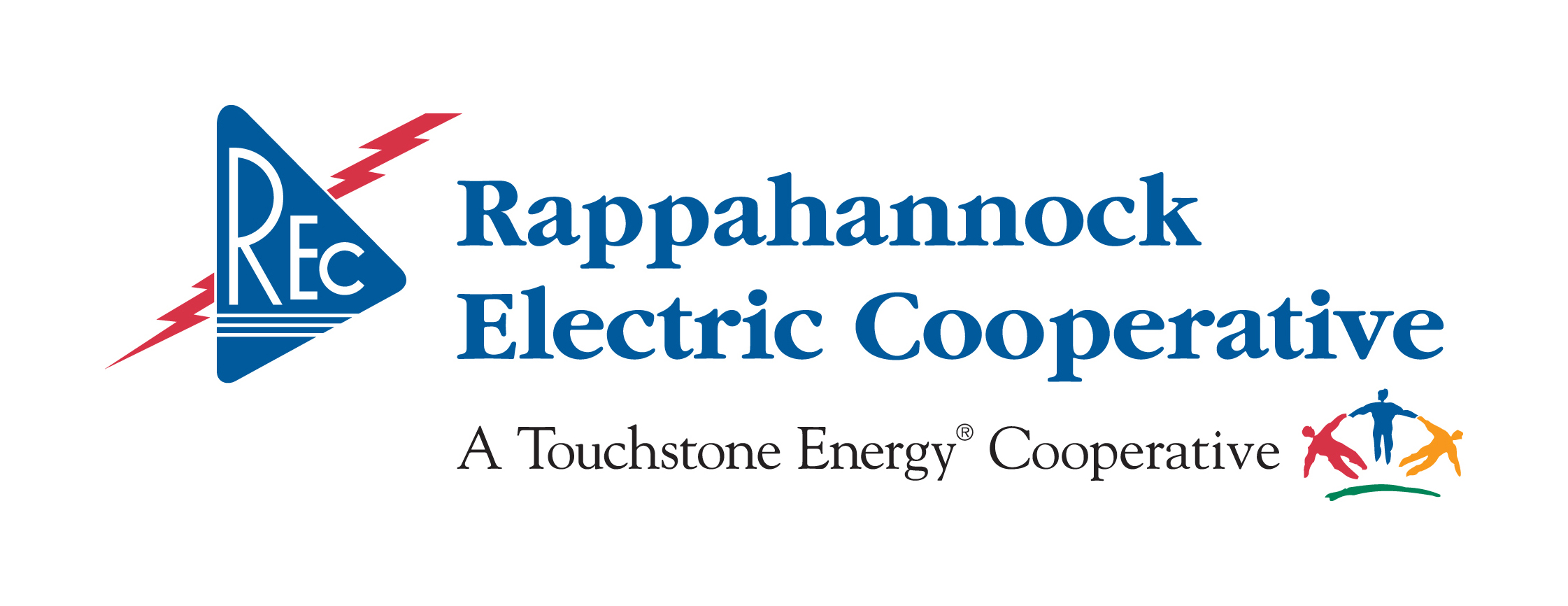As Women’s History Month winds down, we recognize the innovation, achievement, and leadership of women across the energy efficiency industry. Here at the VAEEC, the work women do to advance energy efficiency is obvious – we’re an all women team, with several additional women serving on our Board of Directors and in Executive Leadership. To celebrate, we are recognizing three VAEEC members who lead the pack of women-owned businesses.
Raye Elliott is the Co-Founder and Executive Director of FLIPP Inc a 501c3 nonprofit headquartered in Dillwyn, VA that exists to reduce employment barriers for disadvantaged populations and to empower low-income communities with renewable energy training. Ms. Elliott serves on the board of the Virginia Renewable Energy Alliance (VA-REA), and more notably skyrocketed FLIPP Inc’s annual revenue from under $50,000 to more than $2.3 million within ten months of being appointed as the Executive Director in 2022. Raye holds a master’s degree in information technology, has a background in Hydropower with the US Army Corps of Engineers, and in Construction and Federal Government Contracting with the Department of Defense. Raye recently designed a renewable energy worker-centered sector strategy that was grant funded in 2023 by the USDOL-ETA just shy of $2 million. She has led FLIPP Inc to be the 2023 recipients of the C3 “Energy Equity Award” & the United States Green Building Council-Virginia Chapter’s 2023 “Community Impact Organization of the Year Award”. Raye believes in an “equity in energy” industry strategy, being a great bridge for the barrier ridden, returning back into the workforce and the un-employed individual that needs meaningful employment within a rapidly growing industry.
Jennifer Jesse is the visionary force behind Quick AC Quote (QUACQ), a distinguished SWAM designated Class A contractor licensed in Virginia and West Virginia, where she serves as both founder and Chief Financial Officer. Under Jennifer’s dynamic leadership, QUACQ has earned a sterling reputation for excellence, specializing in large-scale multi-family HVAC replacement projects with a workforce of 20 dedicated employees. With a remarkable capacity to replace 30-40 heat pump systems weekly, QUACQ also extends its expertise to single-family homes, offering comprehensive weatherization services and addressing diverse heating and cooling needs with unparalleled precision. With over 18 years of dedicated service as a Registered Nurse and a further 9 years as a Realtor, Jennifer’s unwavering commitment to helping others has remained steadfast. Whether providing compassionate care to oncology patients, facilitating significant home purchases, or pioneering energy-efficient solutions since 2019, Jennifer’s passion for making a positive impact shines through in every endeavor. A lifelong learner, Jennifer’s love of acquiring new skills and knowledge fuels her success, a trait she attributes to her consistent dedication to growth and innovation.
Driven by a constant commitment to excellence and sustainability, Jennifer continues to lead QUACQ with distinction, empowering her team to reach new heights of success. Through strategic initiatives aimed at employment, education, and certification, Jennifer ensures QUACQ remains at the forefront of the industry. With ambitious plans to expand into multiple East Coast states by the end of 2024, Jennifer’s vision for QUACQ transcends mere business goals; it’s about building a better, more sustainable future for generations to come.
Sandra Leibowitz is the Founder and Owner of Sustainable Design Consulting, LLC (SDC), operating from offices in Richmond, Virginia and Washington, DC. Prior to founding SDC in 2002, Sandra served as Sustainable Design Specialist for three Washington, DC-area architecture and consulting firms, after earning a Master of Architecture degree from the University of Oregon.
Sandra draws from over 30 years of advanced experience with hundreds of sustainable design projects and dozens of organizational programs to serve institutions, building owners, design, construction and property management professionals with expert green building consulting and process management. She leads SDC’s team of experienced and credentialed professionals integrating sustainable design, construction, operations, maintenance, measurement, and reporting concepts into projects of varying size and complexity.
When and why did you start/buy this business?
Sandra Leibowitz: I founded Sustainable Design Consulting (SDC) in 2002. By that point, I had been in the DC-area for some six years, working for three architecture and consulting firms. At that time and in that place, the ideal firm I would have wanted to work for didn’t really exist, so I concluded that I had to either make it myself or just go and join another architecture firm, which would have been the easier path, by far.
Raye Elliott: In September 2020, FLIPP Inc was birthed by myself and my cousin AJ; we started out simply wanting to change mindsets and ended up transforming lives. Our inspiration for the company’s mission was a combination of personal passion and wanting to provide high-quality progressive career avenues for all. The ongoing fight the Historic Union Hill community had to prevent the Dominion Energy ACP from polluting our community was definitely a catalyst event (where we lived our entire childhood lives at), the stagnation observed of the Buckingham County Economic Development and the lack of opportunity in the area.
Jennifer Jesse: Several years ago, I embarked on the journey of founding a HVAC company in Virginia. Our inception as an HVAC enterprise stemmed from a deep-seated desire to aid individuals in need, aiming to provide them with enhanced energy-efficient heating and cooling solutions for their residences. As our commitment to serving our community intensified, our company evolved to encompass a broader spectrum of energy efficiency weatherization measures, meticulously designed to not only optimize home comfort but also alleviate the financial burden associated with homeownership.
What are some ways women can access leadership roles in EE?
Jennifer Jesse: Women can access leadership roles in the energy efficiency (EE) industry through a combination of education, experience, networking, and mentorship. Seeking out opportunities for hands-on experience, volunteering, and professional development can help build skills and credibility. Networking with other women in the industry, joining professional organizations, and seeking out mentors can also provide valuable support and guidance on the path to leadership.
Sandra Leibowitz: You can do what I did: launch your own consultancy, but starting and maintaining a small business can be very challenging in and of itself. These days, there are many existing opportunities in EE policy and practice, both in the public and private sectors. When climbing one of those ladders toward leadership, becoming known externally as a subject matter expert, professional advocate and/or community leader can be very helpful. Of course, some leadership roles are more about organizational management, so if that’s a skillset of yours, as it is among mine, then show your worth by taking on higher and higher levels of internal responsibility.
Raye Elliott: Creating an environment “from the top down” within an organization that encourages women obtaining leadership roles, making gender diversification a NECESSITY and not a PERK, awareness of these roles and proper engagement.
What advice would you give women who are trying to enter the industry?
Raye Elliott: Be persistent, gain experience, get credentialed and master the art of networking.
Jennifer Jesse: My advice to women entering the energy efficiency industry is to be confident in your abilities and passionate about your mission. Don’t be afraid to pursue opportunities, take on challenges, and advocate for yourself. Seek out like minded individuals who can offer support and guidance along the way. Remember that your unique perspective and experiences are valuable assets that can contribute to the industry’s success.
Sandra Leibowitz: Spend at least a few months checking out the types of organizations that you think you might want to work for and read the job descriptions that are offered. Join professional and/or local community organizations and pour some of your time and energy (don’t overdo it!) into initiatives that excite you. Send out resumes to the employers that interest you and request informational interviews, because you never know when the perfect opportunity may open up – it’s so helpful to employers to already have a pipeline of promising candidates at their fingertips when an opening occurs. And don’t forget to keep your LinkedIn profile updated!
What barriers and opportunities do you perceive for women in EE?
Jennifer Jesse: Women in the energy efficiency industry face both barriers and opportunities. Some barriers include gender bias, lack of representation in leadership roles, and limited access to resources and opportunities. However, there are also opportunities for women to excel in the industry, such as the growing demand for sustainable solutions, the emphasis on diversity and inclusion, and the increasing recognition of the importance of women’s contributions. By advocating for gender equity, supporting one another, and leveraging our strengths, we can overcome barriers and create a more inclusive and equitable industry.
Raye Elliott: Barriers for women in EE I’ve observed are 1. stereotypes as to what jobs women ‘should’ do, 2. systemic inequality of opportunity and 3. Just being in a “male-dominated” industry is deemed as a danger to the men because we are a minority and viable competition.
Opportunities are 1. We are many times under-estimated and are able to easily surpass our male counterparts, 2. Where there’s threats there are always opportunities – due to the high disparity there’s an increased emphasis on women in leadership roles and 3. I’ve begun mentoring other women to enter into the renewable energy and energy efficiency sector. If we support, mentor, create avenues for advancement and empower one another, we help ease the transition together.
Sandra Leibowitz: Depending on the specific job and work environment, EE can still be very male-dominated. That’s really not true of sustainable design or green building anymore, so in this case I’m speaking less from direct experience than I am from an observer’s viewpoint. Also, employers know that women tend to be adept at organizing people, programs, and initiatives – which can be a double-edged sword. On the one hand, doing what comes naturally can help raise your profile and get you a seat at the table. On the other hand, women shouldn’t step into or stay in roles just because men won’t – or still assume that it’s ‘women’s work’.
Tell me a little about your background. How did you get into the EE industry?
Raye Elliott: I have a background in hydropower and solar workforce development; renewable energy placed me on a path to learning how integral energy efficiency is and its importance. I had my in-depth exposure with energy efficiency when I worked with the Department of Defense as a construction contracting official and our armory renovations as well as our newly constructed Joint Forces Headquarters buildings had to be LEED certified. I was surprised and fascinated with how much work and the consideration that went into ensuring a “Green Building” was achieved by focusing on the holistic approach to minimize its environmental impact.
Jennifer Jesse: With a background of being a Registered Nurse and Realtor and an understanding of business, I was fortunate enough to step into a platform inside the EE industry that allows me to keep assisting those in need. It has always been my desire to help and extend out a hand when possible to ensure those who are in need are heard and taken care of. Energy Efficiency has allowed me to not only help people but also help this wonderful planet we live on. It has felt like a true blessing to do something so meaningful.
Sandra Leibowitz: I started in this direction – which I guess was originally called ‘environmental architecture’ – way back in 1992 as I was graduating college, where unfortunately I learned little about all this at that time. I did so because I loved architecture, yet considered myself an environmentalist, so put it together for myself by choosing architecture as my environmental career. After grad school at the University of Oregon, where I immersed myself in what we then called ‘ecological design’, I moved to DC, where we instead tended to call it ‘sustainable design’. Over several years working for others, I began what would become my ultimate professional career as a ‘green building’ consultant / consulting firm leader. Living in Richmond for many years further expanded my community into the Central Virginia region.
What is something you wish people of other genders knew about your experiences?
Sandra Leibowitz: Women leaders seem to be expected to make everyone happy all the time. Besides being impossible generally, it’s both unrealistic and unfair to think that others’ happiness is under our control. Furthermore, we don’t tend to burden male leaders with that expectation.
Raye Elliott: It’s extremely hard breaking into an industry that is both white-washed and male dominated. Folks that aren’t clear on my experience and contributions (and those that are clear), have judged, discriminated, and tested me two or three times more than the guys. I personally have been held to a higher standard and had to prove myself more than men I am acquainted with, within the EE and renewable sectors.
Jennifer Jesse: I wish people understood the resilience, determination, and perseverance required to navigate these challenges and succeed in leadership positions as a woman. It’s not just about breaking through the glass ceiling; it’s about constantly pushing against barriers, advocating for oneself and others, and overcoming stereotypes and biases that can undermine our credibility and contributions. Overall, I wish people of all genders would recognize the importance of supporting and empowering women in leadership roles, not just for the benefit of individual women but for the success and resilience of businesses and organizations as a whole.
What’s your favorite EE tip?
Raye Elliott: Turn off the lights when they’re not in use. This is approximately 12% of a usual residential utility bill.
Jennifer Jesse: My favorite EE tip would be to regularly maintain and tune up your HVAC system with the easiest being checking and replacing your filter regularly. Proper maintenance ensures that your heating and cooling equipment operates at peak efficiency, reducing your energy bills, improving comfort, and reducing your carbon footprint. Regular maintenance and smart usage practices are key to maximizing the efficiency and performance of your HVAC system.
Sandra Leibowitz: Bigger isn’t necessarily better – that can be said of buildings themselves, their equipment, and the organizations that own and occupy them. Take a ‘right-sizing’ approach to EE and life in general!
Black history is American history, and while we celebrate this every February, the contributions of the Black community shine year round. This is particularly clear in the energy efficiency industry, where innovators, entrepreneurs, and leaders have paved the way for adoption and advancement for centuries. Lewis Lattimer revolutionized indoor lighting in the 1800s by refining the filament used in light bulbs, turning them from an expensive luxury to an everyday necessity. David Crosthwaite filed more than 43 patents for heating and air conditioning equipment in the 1920s and 30s, and was the first Black man to become a fellow in the American Society of Heating, Refrigeration, and Air Conditioning Engineers. And even more recently, Lisa P. Jackson served as the first Black administrator of the Environmental Protection Agency in 2009, prioritizing indoor air quality and climate change.
As a broad coalition of industry leaders, the VAEEC sees the amazing work our Black colleagues do on a regular basis. To highlight their insights and voices, we asked four members to share their experiences in the energy efficiency field.
Royce Brooks is a Member Service Specialist at Old Dominion Electric Cooperative (ODEC) where she has been employed for the past 25 years. She manages the PJM Demand Response Program for ODEC’s member-owner distribution cooperatives to ensure they are properly registered in the PJM program. She also works with Demand Response and Energy Efficiency (DR/EE) and Strategic Electrification (SE) teams ensuring the successful implementation and verification of programs, supports ODEC’s 11 member-owner distribution cooperatives Load Research program, and helps plan, coordinate and facilitate member education efforts. Royce is a member of the Generation & Transmission (G&T) Distributed Energy Resources (DER) Systems Working Group. She has a BS Degree in Business Administration from Virginia Union University.
McKenna Dunbar is a steadfast advocate for equitable clean energy transitions in frontline and rural communities, with a focus on the intricate intersections of environmental justice, green workforce development, and net-zero building policy initiatives. As the Building Electrification Staffer at Sierra Club Virginia Chapter, McKenna leads a team dedicated to advancing building electrification and reducing fossil fuel dependence. They are also a member of the VAEEC Board of Directors.
Maggie Kelley Riggins is the Senior Program Manage at Southeast Energy Efficiency Alliance (SEEA) and has devoted her career to developing innovative and holistic approaches to understanding and solving gnarly problems faced in the South around climate and energy. Maggie currently manages the building portfolio as SEEA, where she is laying the landscape for equity through climate and workforce in energy efficiency. She manages SEEA’s energy efficient building code and standards work and the building-oriented pilot project models for local governments to increase energy efficiency as a solution for residential, commercial, and municipal buildings. Maggie is leading the nation’s work in drawing direct connections from building energy codes and standards to racial justice, opening new pathways to achieve affordable, healthy, and sustainable housing for everyone.
Anitra Watson is the Energy Conservation Program Manager at Dominion Energy. In her role she oversees the implementation of the Income and Age Qualifying Programs for Virginia and North Carolina, the residential Manufactured Housing Program, and the residential and commercial Multifamily Programs for Virginia. She monitors program progress, quality controls, and financial oversight. Anitra assists with testimony prep, discovery development and provides strategic recommendations. She works closely with Implementation Vendors, the Weatherization Service Providers, and Independent Contractors to ensure successful program implementation.
Why are you passionate about energy efficiency?
Royce: I am passionate about energy efficiency because it helps us save money. And who doesn’t like to save money, especially energy, the one thing we can’t live without! It’s a growing industry from lighting, appliances, renewable energy, beneficial electrification, and weatherization. Having efficient homes and buildings is the key to improving lifestyles.
Maggie: To me, energy efficiency is a way to support people in having a higher quality of life. Improving the energy efficiency of someone’s home or business directly relates to their economic opportunity, their health, and the resilience of their structures – all things that are very important in the Southeast. Getting to work in the energy efficiency and buildings sector affords me the opportunity to have a direct impact on the day to day lives of people and communities.
Anitra: Our health and our living conditions are intimately intertwined. If living conditions are not standard, it can weigh on the physical and mental stability of the individual. By providing energy efficiency we are improving living conditions, changing lives, and so much more. I am passionate because it provides a healthy environment for our customers and a sustainable approach in our industry.
McKenna: My passion for energy efficiency stems from its unique position at the intersection of innovation, equity, and environmental stewardship. This sector represents a fertile ground for technological advancement, where creative solutions can significantly reduce energy consumption, lower utility bills, and contribute to a more sustainable planet.
But beyond the technology, what really does excite me is the potential for energy efficiency to democratize access to clean, affordable energy. By focusing on how to make energy efficiency more accessible and affordable, we can ensure that the benefits of renewable energy and modernized infrastructure reach all communities, not just the affluent ones. This focus on equity ensures that our efforts in energy efficiency can help bridge the gap between different socioeconomic groups, making it a powerful tool for social change.
What brought you to the energy efficiency industry?
Maggie: I am fortunate to have gone to school in the time where energy policy was a degree pathway. I have been interested in sustainability, climate change, and the role of communities since I was in high school and was able to study this further in college at Georgia Tech. The impact keeps me in the energy efficiency sector. Being able to directly support and empower communities, uplift community perspective and voice, and be a champion for better outcomes for folks in the Southeast is a privilege I get to experience every day in this sector.
Royce: When I came to work at Old Dominion Electric Cooperatives(ODEC), I started in IT. When an opportunity came available in Member Services to work with our member-owner distribution cooperatives and facilitate the Energy Efficiency programs, I thought it was a great opportunity to learn about the energy side of the business.
McKenna: My journey into the energy efficiency industry was sparked by my work in building electrification and workforce development in the solar industry. Initially, I was fascinated by the technical aspects of how buildings could be transformed to use energy more cleanly and efficiently. This work opened my eyes to the broader implications of energy use in our daily lives and the potential for systemic change through smarter energy practices. As I delved deeper into this field, I became increasingly aware of the critical role that energy efficiency plays in combating climate change, reducing reliance on fossil fuels, and promoting a healthier environment.
The more I learned, the more I recognized the interdisciplinary nature of the challenge. It was not just about engineering and advocating for better systems but also about understanding the economic incentives for adoption, the regulatory environment, and the social impact of energy policies. This complexity made the field incredibly appealing to me, as it offered the chance to engage with a variety of stakeholders, from policymakers and business leaders to community organizers and homeowners.
Furthermore, the equity aspect of energy efficiency deeply resonated with me. I saw how targeted efficiency improvements could make a significant difference in low-income communities, often the most affected by high energy costs and pollution. This realization solidified my commitment to the sector, as I wanted to contribute to making energy efficiency solutions accessible and beneficial to all, regardless of their economic status. It’s a sector where I believe my efforts can contribute to meaningful, positive changes in the world, making it an endlessly inspiring field to be a part of.
Anitra: In my former role working with Home Revitalization Programs, I would refer my clients to the Energy Conservation Program once the Home Revitalization was completed. This became part of my program process. So, when the opportunity became available, I embraced it. I saw the impacts of energy efficiency and how small changes made a difference.
What do you think the biggest challenges and opportunities are for Black workers entering the field?
McKenna: For Black professionals entering the energy efficiency field, navigating the landscape comes with its own set of unique challenges and opportunities. A significant challenge many face, including myself, is overcoming systemic barriers. One of the most pressing issues is underrepresentation, which complicates finding mentorship and role models. This lack of representation can make it harder to navigate the industry and find the support needed to thrive.
On the other hand, the energy efficiency (EE) industry is brimming with potential, particularly as it begins to prioritize diversity, equity, and environmental justice. This shift is opening up avenues for Black professionals to take the lead and drive innovation. There’s a real chance here to develop sustainable energy solutions, policies, and businesses that not only improve the state as a whole but also specifically uplift communities that are disproportionately affected by energy challenges—like rural, BIPOC, and low-income areas (comprised of leaders who encompass these identities). The industry’s push towards embracing new technologies and tackling climate issues also creates a rich environment for entrepreneurial ventures and innovative projects.
What’s encouraging is the emergence of a support network dedicated to breaking down these systemic barriers and enhancing the representation of Black professionals in the field. However, it’s important to recognize that not all support efforts are created equal. Just because something looks like a bird and sounds like a bird, does not a bird make. True, justice-oriented support will be the key in providing meaningful mentorship, specialized training, and broader career opportunities for Black professionals in the EE industry.
Royce: The biggest challenge is identity. We need to see more African Americans working and operating in their own communities.
Anitra: I think the biggest challenge for any worker entering the field is transparency on how to get started, and where to go for resources.
Maggie: One of the largest challenges I faced was being able to see myself in a role. There are some incredible Black trailblazers in this industry, many of which are now being celebrated, honored, and valued at the federal level. When I came into the industry though, there were fewer individuals who were championing this space, and getting the recognition they deserved in doing so. I’m grateful to have the platforms I have, and to elevate voices of other Black leaders, so that younger Black folks and those who may want to transition to this space see that there is room for them here.
What is one thing about the industry you would like to see change? How can other groups help make that change?
Anitra: I would like to see workforce development opportunities for General Contractors in Energy Efficiency. By providing the opportunity to bridge the gap with licensed and insured contractors, we are paving the way for more experts working in the industry. Other groups can help make the change by design thinking, creating a seamless way to ensure opportunities through education and certification are met and General Contractors are incentivized with work opportunities upon certification completion.
Royce: I would like the industry to recruit from HBCUs, community colleges, and high schools to inform and educate people about the opportunities in the industry. It’s an evolving industry with never ending opportunities and there is so much to learn.
Maggie: I love the shift that is happening for investing in and working alongside communities who have been historically intentionally discriminated against, whether that is through the Justice40 lens or from other equity commitments or companies and organizations. There is so much further to go to meaningfully engage and support communities across the country to realize a clean energy and energy efficient future, though. One thing organizations and companies could do that I would love to see improved is paying people for their time. Community expertise is just as important, if not more important at times, as technical expertise. To do this work well, we need to ensure that when we write community groups, organizations, or representatives into our plans, that we also include them in our budgets.
McKenna: A pivotal shift I envision for the industry revolves around enhancing the inclusivity and justice orientation of entities within the energy efficiency (EE) workforce, ensuring they genuinely reflect the communities they serve. The challenge lies in the distribution of statewide formula funding from federal initiatives, which historically has favored organizations that, intentionally or not, have maintained a monopoly, sidelining partners from disinvested and historically disenfranchised communities. To foster a more equitable distribution, a concerted effort from all stakeholders is imperative. Federal and state agencies could revise funding criteria to prioritize inclusivity and collaboration. Meanwhile, industry leaders and funding bodies should facilitate platforms for dialogue and partnership, ensuring environmental justice and DEIJ-rooted community-based organizations are not just participants but leaders in shaping and implementing EE initiatives. This approach not only democratizes energy efficiency efforts but also amplifies their impact across the commonwealth, fostering a more inclusive and just energy transition.
What’s your favorite EE tip?
McKenna: One of the most effective EE tips I can offer is to consider installing a heat pump in your home. Heat pumps are a versatile and efficient solution for both heating and cooling, operating on the principle of transferring heat rather than generating it, which makes them incredibly energy-efficient. This means they can really help lower your energy bills and cut down on your carbon footprint. They’re good for both heating and cooling, adapting well to different climates, so you stay comfortable all year round. I encourage people to get an energy audit done to assess whether this technology is a right fit for their home!
Anitra: Change your filters, so your HVAC system does not work harder to keep you comfortable.
Maggie: My favorite EE tip is that small things add up. Weather stripping, changing out light bulbs, making sure your attic insulation is up to par, etc. can make huge differences in not just energy bills, but also the comfort and health of your space!
Royce: Cooking on the grill on warm days!! Good food and fun!!
What advice would you give to another member of the Black community when entering the field?
Maggie: I advise everyone to reach out to people in the industry that inspire you. Shoot your shot, as they say. There are so many incredible people who would be more than willing to connect with you, serve as mentors, and see you shine in this industry. This doesn’t have to be a lonely experience – we want to help you!
Royce: The industry is evolving so quickly and there is so much to learn, and the industry provides job security and stability. I have worked in the industry for 25 years and I continue to grow and develop.
McKenna: Keep believing in the heart of the mission, no matter what fluff you see surrounding you. The mission can be personal. For me, I believe energy efficiency is an important tool in the clean energy transition toolbox. It means that this tool has the collective power of alleviating and mitigating the suffering of millions across the country, much less hundreds of thousands in the Commonwealth.
It means that in your own unique way, the work you are engaged in means something to someone out there. Stay motivated by the difference your contributions make, however big or small, knowing that each step forward is a stride towards a justice-oriented world. Believe in your voice and ask yourself and your collaborators, what is our vision if we cease to believe in the mission?
Anitra: The work in this field changes lives, the assistance you provide will have an impact on the lives of others.
What’s the weirdest job you’ve ever had?
Anitra: When I was working in the field, I spent the day with my Energy Auditor. We visited a home that applied for the Department of Social Services Crisis program, they had no heat. When we arrived at the home, the father replaced the flue on the wood stove with a dryer vent hose. He created a fire in the wood stove using gasoline. The gas containers were between the wall and the back of the wood stove. Due to age, the entire unit was glowing. I am so glad we were able to prevent a bad situation escalating to something worse.
McKenna: Reflecting on the most unconventional role I’ve had, working as a mortician’s assistant stands out. This role, while initially seeming “weird,” offered profound insights into the cycles of life and death, teaching me invaluable lessons about authenticity and purpose. The experiences gained in this position- observing the finality of life and the importance of living with intention—have profoundly influenced my approach to social impact work, especially in areas like energy justice and climate mental health. It underscored the significance of embracing each day with purpose and has guided my career trajectory in meaningful ways.
Royce: The weirdest job I ever did was to go out in the field to probe a meter.
Maggie: I thankfully haven’t had many weird jobs, but in high school I volunteered in school collecting people’s old shoes for recycling. Very smelly work!
The Virginia Energy Efficiency Council was excited to gather in person with Virginia’s energy efficiency industry leaders for our annual Spring Forum on May 5th. Thank you to our sponsors, speakers, and attendees for making this event a great success!
Our biannual forums are known for their ability to bring together Virginia’s energy efficiency leaders to make valuable connections, and this event did not disappoint. Energy efficiency professionals convened in person at the Dorey Recreation Center in Henrico County for ample networking time, a keynote address from a prominent energy-efficiency champion, educational presentations, a membership spotlight, and the organization’s annual business meeting with Board elections.
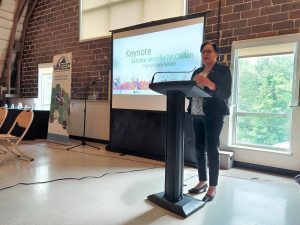
Senator Jennifer McClellan
The event kicked off with a brief opening presentation from Executive Director, Chelsea Harnish, who provided an update on the organization’s 2022 accomplishments thus far. Attendees were then treated to a keynote address from Virginia State Senator Jennifer McClellan, a long-time advocate for clean energy in the Commonwealth. Senator McClellan began by stating the importance of clean energy before specifically discussing the numerous benefits of energy efficiency; “energy efficiency is the cheapest way and the zero-carbon way to have clean energy”. She also provided a recap of recent clean energy legislation, including the Virginia Clean Economy Act and the Regional Greenhouse Gas Initiative, insisting that Virginia must continue taking action to remain a clean energy leader. We are in the midst of transiting to clean energy; Virginia can continue to be a leader, or it can be at the end of the pack.
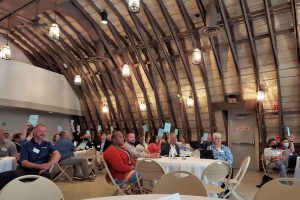
Members voting during the Board election
Next was our annual business meeting, a dedicated time where we hold our Board of Directors election and have our members share their accomplishments. Chelsea Harnish started this portion of the meeting with organizational updates, including the process of developing our 2023-2025 strategic plan. Afterward, Board Vice-Chair Mark Jackson (CHP Energy Solutions) led our 2022 Board of Directors election. VAEEC members re-elected seven Board members:
- Elizabeth Beardsley, U.S. Green Building Council
- Tim Bernadowski, Siemens Industry
- KC Bleile, Viridiant
- Bill Eger, City of Alexandria
- Stephen Evanko, Dominion Due Diligence Group
- Mark Jackson, CHP Energy Solutions, and
- Carrie Webster, Henrico County
Members elected Megan Partridge with Franklin Energy to fill an open seat on the Board of Directors. We also officially welcomed Joyce Bodoh (Rappahannock Electric Cooperative) and Bryna Dunn (Moseley Architects) to the Board. These individuals are fulfilling the terms of former Board members. We are excited to add new voices to our leadership and to continue working with our seven re-elected members.
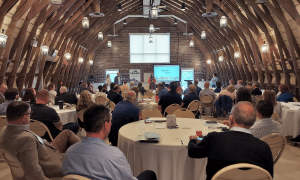
Remarkable Member Updates
After the remarkable member updates, a time for members to highlight their latest successes, and a networking break, attendees reconvened for our plenary session, Advancing Energy Efficiency in the Built Environment. Speakers included: Bryna Dunn (Moseley Architects), Andrew Grigsby (Viridiant), Abby Johnson (Virginia PACE Authority), and Benjamin Knopp (Community Housing Partners). Julia Reynolds (Chesterfield County) moderated.
While the keynote address focused on past successes and an overview of this year’s General Assembly session, this session was more forward-focused. Speakers touched on the latest and greatest opportunities for the field right now and their predictions for the next five years. They also covered the challenges and barriers, as well as the opportunities, they are seeing in their particular niche of the energy efficiency industry.
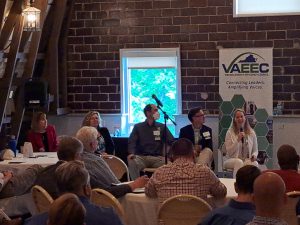
Advancing EE in the Built Environment
Abby focused on the statewide Commercial Property Assessed Clean Energy (C-PACE) program, including recent legislation that enhances the scope of C-PACE projects. Andrew emphasized the value of efficiency and green design and using funding to support social good. He also discussed the energy code work that Viridiant is doing with the Southeast Energy Efficiency Alliance. Ben talked about pushing the boundaries of weatherization with MERV-13 filtration, heat pump deployment, electrification, and weatherization deferral repairs. Bryna provided an overview of Moseley’s True Sustainability Program and how it ties together wellness, decarbonization, and resilience.
After closing remarks, the event concluded with a happy hour at Triple Crossing – Fulton in Richmond. With networking being one of the main benefits of a VAEEC membership, we were delighted to safely offer this in-person opportunity. It was a pleasure to connect with many of our members face-to-face again after primarily hosting virtual events for the past two years.
Thank you to our sponsors, speakers, and event attendees for making this one of our best events to date!
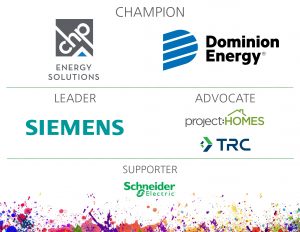
Additional event information, including speaker biographies and sponsor features, can be found in the event program. Event attendees received a PDF of the event’s presentation in the post-event email. Contact info@vaeec.org if you did not receive it. Events photos can be viewed in the photo gallery below.
Columbia Gas of Virginia (Business Silver member) has launched a new phase of WarmWise, the company’s energy efficiency and conservation program aimed at reducing customers’ energy usage. With this new phase comes enhanced programs for both residential and business customers. WarmWise is also continuing to partner with contractors across Virginia to educate customers on these rebate programs.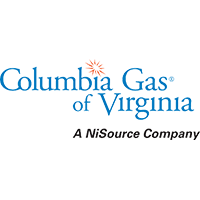
In addition to continuing residential rebates offered for floor insulation, attic insulation, energy efficient windows and gas furnaces, the WarmWise Home Savings Program now offers rebates for smart thermostats and energy efficient doors and skylights. Through the Business Savings Program, commercial customers may receive rebates for smart thermostats, high-efficiency gas furnaces and attic insulation in addition to previously offered rebates for boiler controls, infrared heaters and free high-efficiency pre-rinse spray valves.
 Also new to the program, residential customers may qualify for up to two free Energy Efficiency Kits when they complete the WarmWise Home Savings Evaluation – a free online home energy audit. Customers with natural gas space heating can now receive a free Energy Efficiency Kit with door sweeps and weather stripping. The Energy Efficiency Kit containing faucet aerators and high-efficiency shower heads is again available to customers with natural gas water heating. All customers who complete the evaluation will also receive energy savings tips customized to their homes.
Also new to the program, residential customers may qualify for up to two free Energy Efficiency Kits when they complete the WarmWise Home Savings Evaluation – a free online home energy audit. Customers with natural gas space heating can now receive a free Energy Efficiency Kit with door sweeps and weather stripping. The Energy Efficiency Kit containing faucet aerators and high-efficiency shower heads is again available to customers with natural gas water heating. All customers who complete the evaluation will also receive energy savings tips customized to their homes.
To learn more about energy-saving opportunities, visit WarmWiseVA.com.
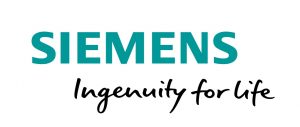 For over 165 years, Siemens has built a reputation for delivering leading-edge products and services, high levels of customer satisfaction, and an unending spirit of innovation. As a $100B company with over 370,000 employees in 190 countries, Siemens is a global powerhouse in electronics and electrical engineering, industry, energy, healthcare, infrastructure, and building automation.
For over 165 years, Siemens has built a reputation for delivering leading-edge products and services, high levels of customer satisfaction, and an unending spirit of innovation. As a $100B company with over 370,000 employees in 190 countries, Siemens is a global powerhouse in electronics and electrical engineering, industry, energy, healthcare, infrastructure, and building automation.
From initial assessment through ongoing support, the Building Technologies Division of Siemens Industry, Inc. is the world market leader for safe, reliable, energy-efficient, and sustainable buildings and infrastructures. As a service provider, system integrator, and product manufacturer, Siemens offers sustainable building products, technologies, and solutions that help optimize building automation, fire safety and security systems, HVAC, air quality, power distribution and management, and energy efficiency. Our systems, services, resources, and experience help ensure facilities are safe, efficient, and compliant.
As a true full-service energy services company (ESCO), Siemens provides the industry’s most comprehensive end-to-end energy solutions – from energy reduction to production and procurement – enabling cities to best achieve energy and water goals while positively impacting the economy and environment. Siemens extensive expertise in guaranteed performance-based solutions, combined with our scalable, proven portfolio, allows us to most efficiently and effectively meet the needs of all communities, including small-, medium-, and large-sized cites.
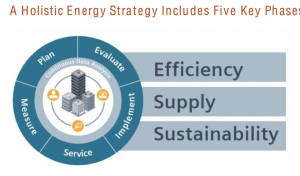
Siemens Commissioning Advantage Program (CxA) is a comprehensive building energy and performance optimization program designed to improve the way facility mangers operate their facilities. This program includes a variety of individual offerings that have a far greater impact when combined as a holistic solution.
Siemens’ white paper, “Commissioning: An Essential Part of a Comprehensive Energy Strategy,” talks about how and why Commissioning should be included in a company’s energy plan. Here is an excerpt from that white paper:
“Through proper assessment and planning, a comprehensive energy strategy that includes commissioning will serve as a roadmap to maximize building performance. A fragmented approach to commissioning can compromise the long-term health of the building; it is important to integrate commissioning into a facility’s energy management strategy. Depending on the building’s level of energy-efficiency, age, and use, the commissioning approach will be comprised of both one-time initiatives and ongoing services, and both are designed to reduce energy costs while enabling continuous performance improvements.”
A Holistic Energy Strategy Includes Five Key Phases
- Strategy & Planning
- Evaluation & Assessment
- Program Implementation
- Ongoing Services & Optimization
- Measurement & Reporting
Learn more at www.usa.siemens.com/commissioning or contact:
Janet S. Tribble
Siemens Industry, Inc.
Building Technologies Division
Business Development, Building Performance & Sustainability
janet.tribble@siemens.com
804-426-1980
May 2016
Pearl National Home Certification
Business Silver Member
Pearl National Home Certification is a Virginia-based startup launched in 2015. Pearl is dedicated to increasing the energy efficiency and comfort of existing homes and will transform the market by helping homeowners capture the value of their home energy upgrades for resale or refinance. Network contractors and real estate agents grow their businesses when they become Pearl Partners by providing their clients access to Pearl’s special services, such as exclusive rebates and lending products, and a “My Home Profile” account to track progress towards certification.
At the helm are Co-Founders Cynthia Adams, also founder and President of the VAEEC and formerly the Executive Director of the Local Energy Alliance Program; and Robin LeBaron, formerly Managing Director of the National Home Performance Council. Pearl is an official partner with the Department of Energy’s Home Performance with ENERGY STAR program, running pilots in central and northern Virginia.
How Does Pearl Work?
 Pearl’s certification service is used by contractors to verify and score a home’s energy assets for certification. When a home’s features earn it enough points, Pearl issues a BRONZE, SLIVER, GOLD, or Net Zero certificate and Home Energy Asset Inventory report. Real estate agents use Pearl’s services to help sellers market their energy efficient home and to help buyers maintain and improve their “new” home through an exclusive “My Home Profile” account. “My Home Profile” provides homeowners with a plan to achieve certification, as well as online resources for maintaining their home. Pearl’s software also functions like a virtual general contractor, helping homeowners find contractors to make improvements and tracking progress made over time.
Pearl’s certification service is used by contractors to verify and score a home’s energy assets for certification. When a home’s features earn it enough points, Pearl issues a BRONZE, SLIVER, GOLD, or Net Zero certificate and Home Energy Asset Inventory report. Real estate agents use Pearl’s services to help sellers market their energy efficient home and to help buyers maintain and improve their “new” home through an exclusive “My Home Profile” account. “My Home Profile” provides homeowners with a plan to achieve certification, as well as online resources for maintaining their home. Pearl’s software also functions like a virtual general contractor, helping homeowners find contractors to make improvements and tracking progress made over time.
Why Homeowners Sign Up with Pearl
Pearl offers homeowners:
- An initial estimate of the home’s certification level through a free My Home Profile account
- Information on rebates and loans to help pay for energy, health and other home improvements
- Access to a network of high-quality, specially trained Pearl-Approved Contractors
- Certification of a home’s energy efficient and health features
- Documentation and marketing services to help sell a certified home
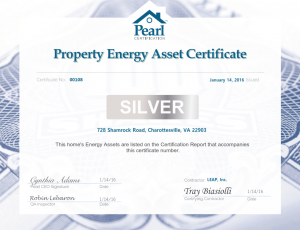 Interested homeowners who want to sign up for Pearl can do so here: www.yourhomeprofile.com.
Interested homeowners who want to sign up for Pearl can do so here: www.yourhomeprofile.com.
You can check out a sample certification report here.
How Contractors Benefit with Pearl
Pearl’s software provides quality contractors a marketing and certification system to enhance home performance and energy efficiency sales. Network contractor benefits include:
- Client engagement from the first appointment on
- Increased job size through certification services
- Relationship marketing through Pearl’s email services
- Homeowner referrals from Pearl Partners
- Differentiation from low bid/low quality competitors
This list of benefits results in increased revenue for contractors: the average insulation sales person can generate over $100K in additional yearly sales with Pearl, and the average HVAC sales person double that number. To learn more about how contractors can grow their business with Pearl, visit www.pearlcertification.com/contractor.
How Real Estate Agents Benefit with Pearl
Realtors have been among Pearl’s earliest and strongest partners, given the mutual interest in helping home buyers create value, and sellers access it.
The National Association of Home Builders found that nine out of ten buyers would rather purchase a home with energy-efficient features, and would be willing to pay more for it. A recent study by the Appraisal Institute and the Institute for Market Transformation found that Washington, D.C. homes that were certified energy efficient sold for a 3.6% price premium. It’s representative of what we’re seeing across markets in the U.S. where, on average, third party certified homes are selling for 4-5% higher. On a $500K home, this can be $25K in added value sellers are currently leaving on the table.
As a Pearl Partner, real estate agents get:
- Buyer’s closing gift of a Pearl “My Home Profile” account
- Monthly client emails with informative and timely maintenance tips
- Training on selling the energy efficient home
- Special certification report package and other marketing tools for selling the certified home
- Client referrals from our Pearl Network contractors
 Real estate agents interested in learning more should visit pearlcertification.com/homevalue/
Real estate agents interested in learning more should visit pearlcertification.com/homevalue/
April 2016
Schneider Electric
Business Silver
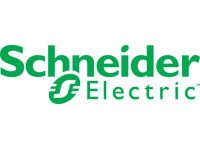 Schneider Electric is the global specialist in energy management and automation. With revenues of ~$30 billion in FY2015, their 160,000+ employees serve customers in over 100 countries, helping them to manage their energy and process in ways that are safe, reliable, efficient and sustainable. From the simplest of switches to complex operational systems, their technology, software and services improve the way their customers manage and automate their operations. Their connected technologies reshape industries, transform cities and enrich lives. They call it “Life Is On.”
Schneider Electric is the global specialist in energy management and automation. With revenues of ~$30 billion in FY2015, their 160,000+ employees serve customers in over 100 countries, helping them to manage their energy and process in ways that are safe, reliable, efficient and sustainable. From the simplest of switches to complex operational systems, their technology, software and services improve the way their customers manage and automate their operations. Their connected technologies reshape industries, transform cities and enrich lives. They call it “Life Is On.”
In the past 23 years, Schneider Electric’s Energy and Sustainability Services team has successfully implemented more than 550 energy savings performance contract (ESPC) projects across the nation and has helped clients around the world save nearly $2 billion. This project delivery method helps publicly funded entities make capital improvements over longer payback periods and offers many long-term benefits such as improved facility efficiency, occupant comfort, financial management and environmental protection.
Two areas where they focus are on schools and cities. Here is an excerpt from their in-depth and compelling Sustainability Mythbusters piece on the hidden value of sustainability for municipalities and schools: 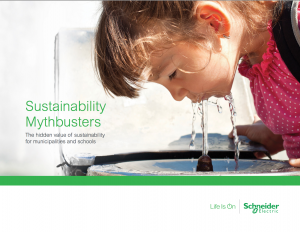
The word “sustainability” may conjure thoughts of recycling, reusable cloth bags and big piles of compost. But for many government entities, sustainability has little relation to these stereotypical green ideas and much more to do with operational efficiency, improved outcomes and a better bottom line. Not only are schools and municipalities adopting sustainability initiatives to satisfy government mandates and public pressures, but they are also using it as tool to become more competitive in today’s economy. In fact, government organizations practicing sustainability are outperforming their peers in areas like job growth, student recruitment, and increased tax revenue. Learn more about how your city, school or university can benefit from a modern sustainability program.
Schneider Electric’s Sustainability Mythbusters piece explores the top 5 misconceptions about sustainability, while highlighting specific case studies, trends, implications and facts around the topic.
1. There is no demand for sustainability in municipalities and schools
2. Sustainability does not make business sense
3. Sustainability is all about being green
4. Sustainability is too expensive
5. The impacts of sustainability are limited
Learn more at www.enable.schneider-electric.com or contact your local representative:
Barry Wilhelm
Schneider Electric
Energy and Sustainability Services, Team Leader
Phone: 804 486 1005 | Mobile: 540 798 3220
Email: barry.wilhelm@schneider-electric.com
March 2016
Featured Member of the Month: Rappahannock Electric Cooperative (REC)
Business Gold Member
 Rappahannock Electric Cooperative (REC) serves more than 160,000 homes and businesses across its 22-county service area, which stretches from the West Virginia border in Clarke County south to near Charlottesville and east to West Point. As a not-for-profit, consumer-owned utility, REC is committed to providing value to its members. While reliable and affordable electricity is the foundation of REC’s mission, support to local communities, consideration of the environment, and service to its members complete REC’s value equation.
Rappahannock Electric Cooperative (REC) serves more than 160,000 homes and businesses across its 22-county service area, which stretches from the West Virginia border in Clarke County south to near Charlottesville and east to West Point. As a not-for-profit, consumer-owned utility, REC is committed to providing value to its members. While reliable and affordable electricity is the foundation of REC’s mission, support to local communities, consideration of the environment, and service to its members complete REC’s value equation.
“REC’s Core Values are Caring, Integrity, Respect, and Service,” says David Koogler, REC vice president of member and external relations (and VAEEC Governance Board member). “Adhering to those values means more than just selling electricity. We want our members to use electricity efficiently. Wise and efficient use of electricity helps consumers receive more value for their energy dollars, results in more satisfied consumers, and conserves natural resources,” explains Koogler.
The Cooperative encourages and facilitates energy efficiency through multiple communication channels, including social media, traditional advertising, Cooperative Living – a very popular magazine exclusively provided to its members, bill messages, well versed agents in its contact center, numerous online options, and phone and on-site energy consultations. An excellent example of the variety of REC Efficiency Programs and advice is found in the pages of the current issue of Cooperative Living.
 REC recognizes that the first step toward efficient use of electricity is to increase awareness of energy use. An innovative program called myusage.com helps create that awareness. Members enrolled in the myusage service can receive daily usage information via email or alerts when usage exceeds preset boundaries. The program overlays weather information to help explain why usage varies from day-to-day. If daily usage increases without a corresponding change in weather, the consumer is alerted to potential problems, such as a heat pump operating in the emergency mode, and can take corrective actions sooner, before receiving an unusually high monthly bill.
REC recognizes that the first step toward efficient use of electricity is to increase awareness of energy use. An innovative program called myusage.com helps create that awareness. Members enrolled in the myusage service can receive daily usage information via email or alerts when usage exceeds preset boundaries. The program overlays weather information to help explain why usage varies from day-to-day. If daily usage increases without a corresponding change in weather, the consumer is alerted to potential problems, such as a heat pump operating in the emergency mode, and can take corrective actions sooner, before receiving an unusually high monthly bill.
Visit the Energy Center at myrec.coop to learn more about the myusage service and REC’s other efficiency programs.
February 2016
Featured Member of the Month: Community Housing Partners (CHP) and their work with Weatherizers Without Borders (WWB)
Business Gold Member
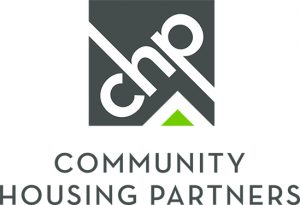 Christiansburg-based Community Housing Partners, or CHP (Business Gold VAEEC member), does incredible work creating and sustaining “communities that promote vitality in neighborhoods, foster wealth-building for individuals, and contribute to a better environment for future generations” through sustainable development, architectural design, construction, homeownership,, housing management, resident services, energy training and research, emergency home repair, and weatherization.
Christiansburg-based Community Housing Partners, or CHP (Business Gold VAEEC member), does incredible work creating and sustaining “communities that promote vitality in neighborhoods, foster wealth-building for individuals, and contribute to a better environment for future generations” through sustainable development, architectural design, construction, homeownership,, housing management, resident services, energy training and research, emergency home repair, and weatherization.
But what’s equally impressive is their work not just outside the Commonwealth but outside the United States. As a founding partner of Weatherizers Without Borders (WWB), CHP works with various global entities to fight energy inefficiency and energy poverty in order to improve the health, safety, comfort, and economy of families across the globe in Central and South American countries. They help introduce programs like the U.S. Department of Energy’s Weatherization Assistance Program as public policies in these regions, and CHP Energy Solutions Research and Training has trained WWB volunteers in both Virginia and Argentina.
 CHP’s Chase Counts is one of several subject experts from the Training Center who have provided training and technical assistance in Buenos Aires, Argentina. “During my three-week stay, we were able to provide hands-on field training to 15 installers, an additional 8 student-volunteers that would continue developing the trainings, and we held a two week building science intensive course at the Instituto Tecnologico Buenos Aires for 25 architects, engineers, utility professionals, professors, and interested students,” explains Chase, “There is a strong interest and demand for weatherization work that extends beyond saving energy to also include improving quality of life and making households healthier.”
CHP’s Chase Counts is one of several subject experts from the Training Center who have provided training and technical assistance in Buenos Aires, Argentina. “During my three-week stay, we were able to provide hands-on field training to 15 installers, an additional 8 student-volunteers that would continue developing the trainings, and we held a two week building science intensive course at the Instituto Tecnologico Buenos Aires for 25 architects, engineers, utility professionals, professors, and interested students,” explains Chase, “There is a strong interest and demand for weatherization work that extends beyond saving energy to also include improving quality of life and making households healthier.”
WWB is preparing to host their third International Summit on Weatherization at the Virginia Tech Research Center in Arlington in early March. The Summit will be complemented by speakers and presentations on weatherization both in the US and Latin America. The presentations will be followed by workshops discussing how to building international sustainable housing polices and the role of universities in this challenge.
We wrote about WWB back in January 2014 when things were just getting started.
You can learn more about WWB’s work in Uruguay and the overall global reach of WWB.
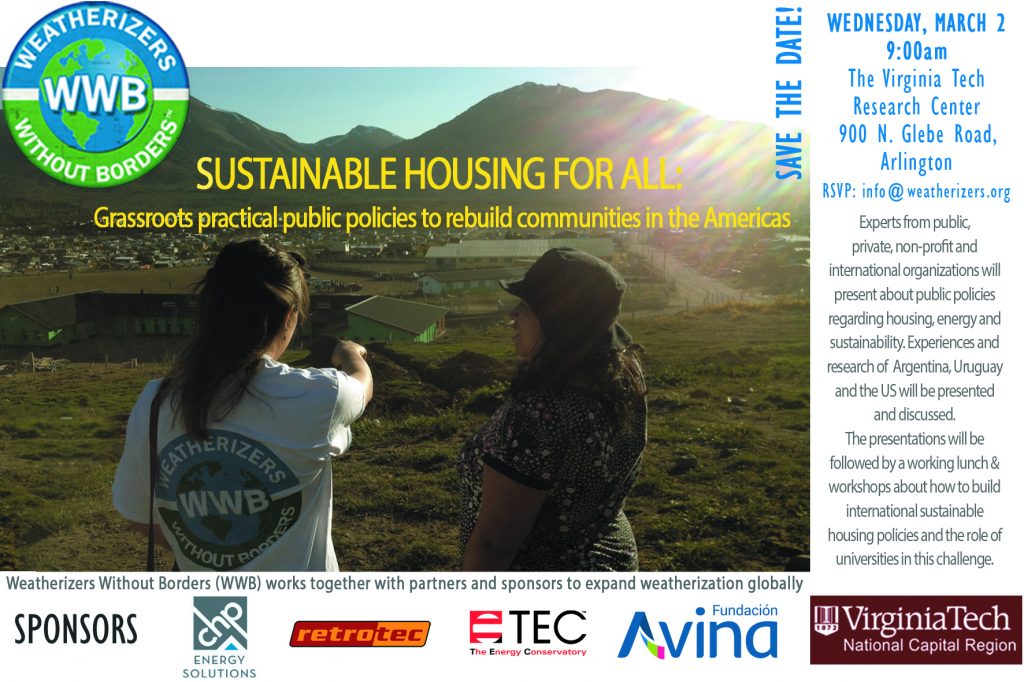
January 2016
Dominion Virginia Power
Gold Level Member
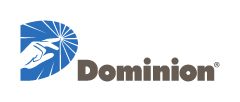
Dominion Virginia Power is a subsidiary of Dominion (NYSE: D), one of the nation’s largest producers and transporters of energy with operations in 14 states. Dominion Virginia Power offers 6 non-residential, and 7 residential programs that empower customers to manage their energy consumption, resulting in lower bills throughout the year. The company recently expanded its EnergyShare program to provide financial assistance, weatherization services and educational outreach to more qualifying customers, including people living with disabilities and military veterans facing financial hardships. As a regulated utility, Dominion regularly reviews and proposes new programs for approval to the State Corporation Commission (SCC). Currently under consideration by the SCC are a residential programmable thermostat program and a small business program.
To view the current list of programs and incentives for Dominion customers visit the Energy Conservation home page.

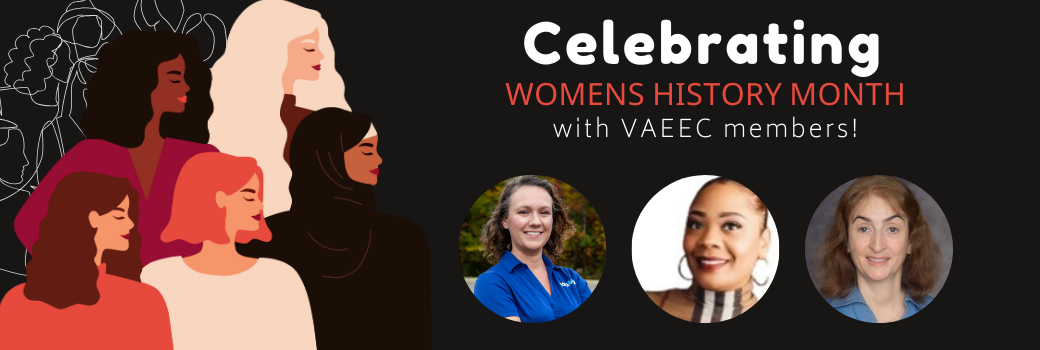
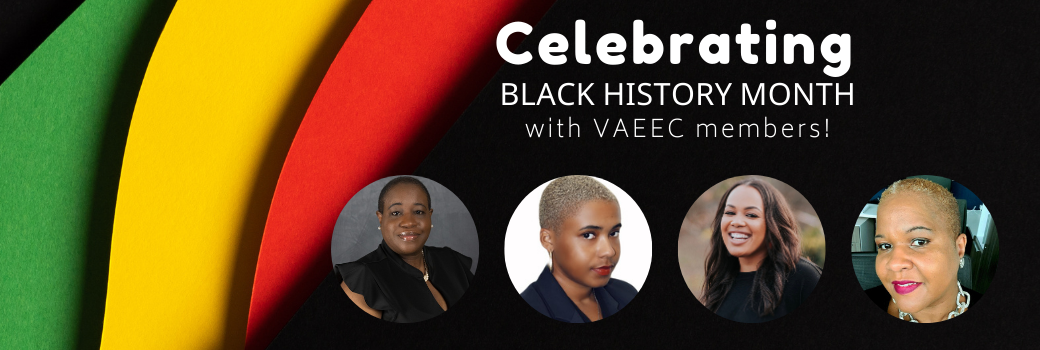
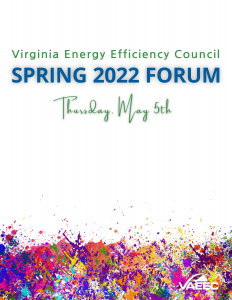






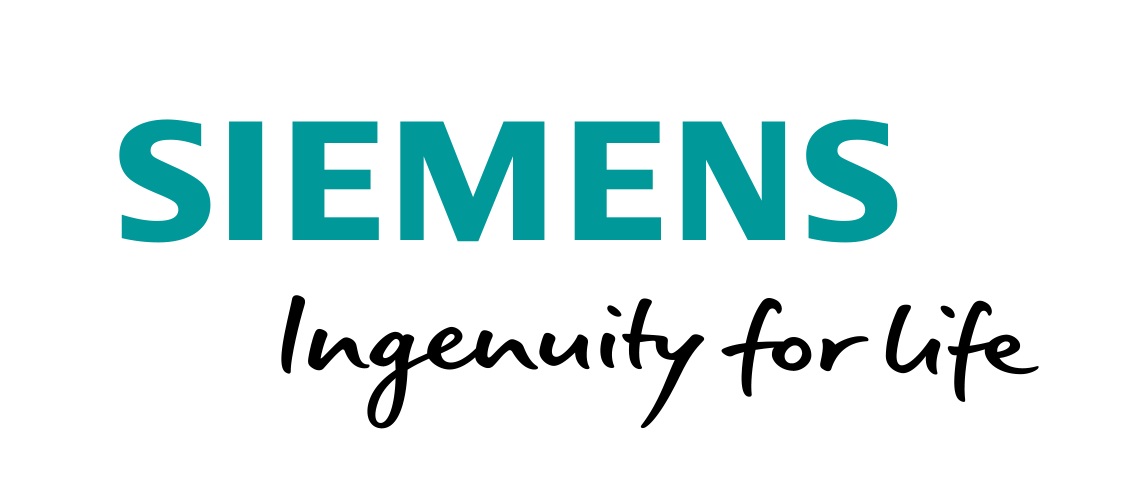
 For over 165 years,
For over 165 years, 







